
 Copyright © Michael Richmond.
This work is licensed under a Creative Commons License.
Copyright © Michael Richmond.
This work is licensed under a Creative Commons License.
On May 9, 2005, news services started to spread a story with a wild headline: Astronomers detect creation of a black hole.

Wow! Really?
Well, maybe. To find out just what this means, we have to go back in time to gain some background on one particular sort of astronomical source, the mysterious gamma ray bursts. We'll come back to this recent event eventually.
Gamma Ray Bursts (GRBs) are brief, elusive, but outrageously luminous events --- which were discovered by accident!
An excellent source of information is an account by Ray Klebasabel, a scientist who worked on the Vela Project. In the 1950s, the few nuclear powers -- US, USSR, Great Britain (France would join in 1960 and China in 1964) -- decided that a ban on the testing of nuclear weapons would be a good thing. But how would each country know that the other was abiding by the terms of some Test Ban Treaty?
There are several distinctive signatures by which one may detect nuclear explosions remotely:
The US pursued each of these avenues. One of them -- gamma rays -- produced a surprise.
Gamma rays are very, very energetic electromagnetic waves; they have energies billions or trillions of times greater than optical photons.

They are produced in great quantities in nuclear reactions. In order to detect bombs exploded above the surface of the Earth, the US designed a set of satellites which would orbit the Earth to look for gamma rays. The satellites were launched in pairs, so that each could watch over roughly half of the planet. The first pair entered orbit in 1963, the second pair in 1964, and the last pair in 1965.
As scientists scanned the records from the satellites, they found evidence for short bursts of gamma rays which could not be due to nuclear weapons; some, for example, were detected by satellites on opposite sides of the Earth. The detectors typically showed a sharp initial peak of gamma rays, followed by a more gradual decline over seconds or minutes. What were they?
Some bursts were detected by more than one of the Vela satellites. The difference in the arrival times of the gamma rays at each satellite could sometimes indicate a very rough direction.
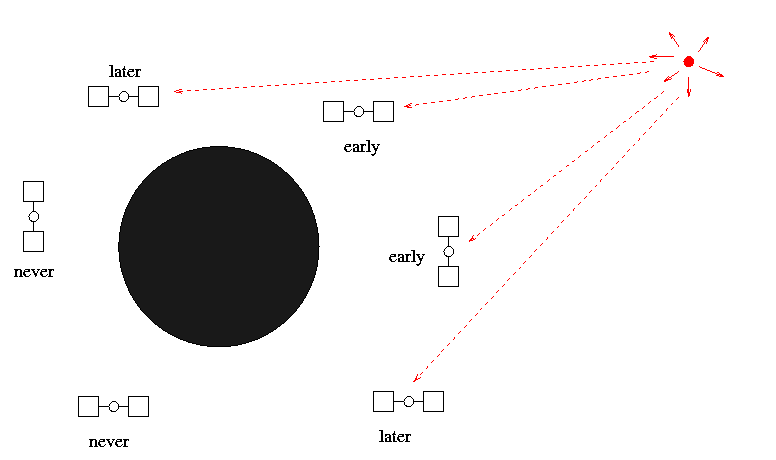
If the sources of the bursts were somewhere in the Solar System, then they would (probably) be located somewhere in the ecliptic plane: that's the plane in which the Earth and all the other planets orbit around the Sun. But, instead, the bursts sometimes came from above the plane, and sometimes from below the plane. So they probably originated somewhere far outside the Solar System ...
The GRBs were a closely guarded secret for many years. It wasn't until 1973 that the members of the Vela team were allowed to tell other scientists of their existence.
Sometimes, one can use the wavelength at which an object emits electromagnetic radiation to guess at some of its properties. The wavelength of peak thermal radiation shrinks as the temperature of an object increases; you may recall the equation
2,900,000 nm * K 0.29 cm * K
Temp = ------------------- = ----------------
peak wavelength peak wavelength
Q: A typical GRB emits most of its energy at
a wavelength of very roughly 0.02 nm.
If you use the blackbody approximation to
estimate its temperature, what do you conclude?
The answer
But it's just not possible for objects to be so hot that they emit many gamma rays; they are too energetic, even for bodies with temperatures of millions of degrees. Instead, gamma rays can be produced
So, what could be producing these bursts? We know that when some stars explode, becoming very bright supernovae for a few weeks, the material at their core undergoes nuclear reactions which can give rise to gamma rays. Perhaps supernovae are the sources. Now, there have been no supernovae in our own galaxy for several centuries; but we can see a few hundred supernovae occur in nearby galaxies. If this idea is right, then some GRBs might occur at the same time and in the same place as supernovae we detect in the visible part of the spectrum.
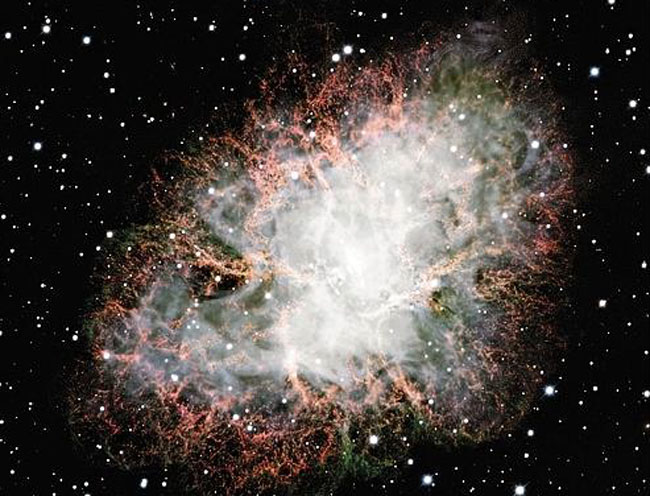
Image copyright
Canada-France-Hawaii Telescope,
J.-C. Cuillandre (CFHT),
Coelum , as seen on
Astronomy Picture of the Day for 2004 Jan 28
Another theory is that material in an accretion disk around a black hole or compact star might somehow be accelerated to relativistic speeds (some accretion disks do appear to have relativistic jets of material shooting outwards). Accretion disks are found in close binary star systems, in which a compact star can rip material from a nearby companion. Below are some artist's impressions of close binary systems with accretion disks:
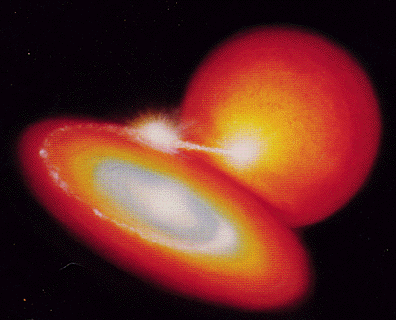
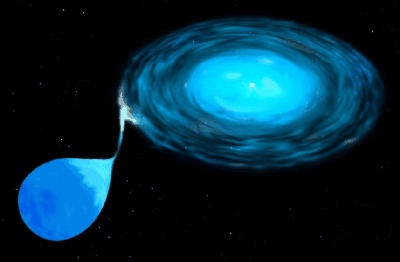
Yet another theory involves two compact objects -- black holes or neutron stars. We know that some binary systems consist of two neutron stars, or a black hole and a neutron star. If the two objects move in a small enough orbit, they will eventually lose energy to gravitational radiation. When they get VERY close to each other, they can merge into a single massive object. The merging process is not understood well, but is certain to be violent and energetic; maybe it could produce a short burst of high energy radiation ....
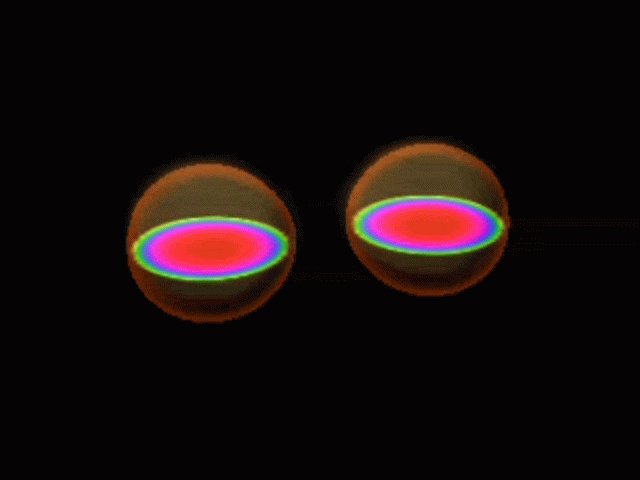
Click on the image to see a simulation of the merging
So, which of these ideas is the right one? Or -- are they all wrong?
"Easy," you might say, "all you have to do is look at the gamma-ray burst with all sorts of other telescopes, and then you'll know what causes it."
Unfortunately, it isn't that simple, mainly because gamma rays are notoriously hard to focus. Gamma-ray detectors can do little more than indicate the general part of the sky from which gamma rays came: the burst might be anywhere within an "error circle" of 5 to 10 degrees in size:

There are thousands to millions of faint objects visible to optical telescopes in such a large area. Which one (if any) corresponds to the gamma-ray burst? In most cases, we just don't know....
A typical GRB consists of a sharp peak of gamma rays (hence the name):
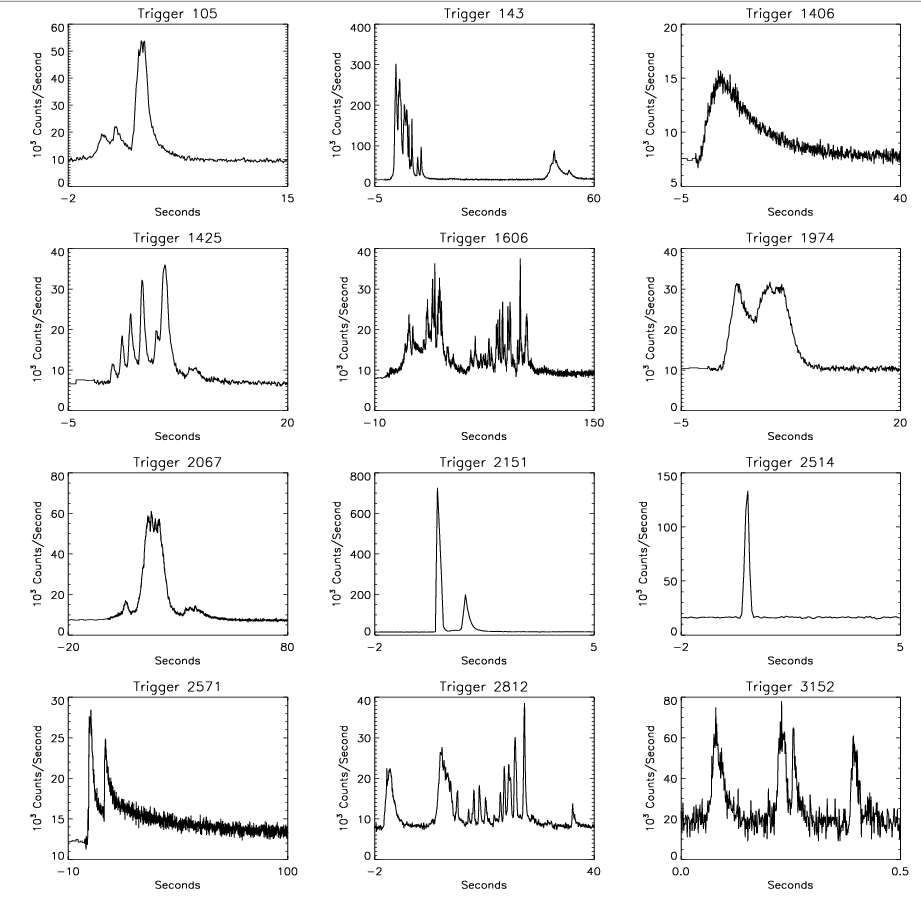
There is quite a variety of events, however: some are very short, some long. Some have multiple peaks, some just a single spike. The properties of GRBs cover quite a range.
After decades of study, however, as the number of events grew and grew, astronomers eventually decided that one could put GRBs into several "families", based mostly on the duration of the event.
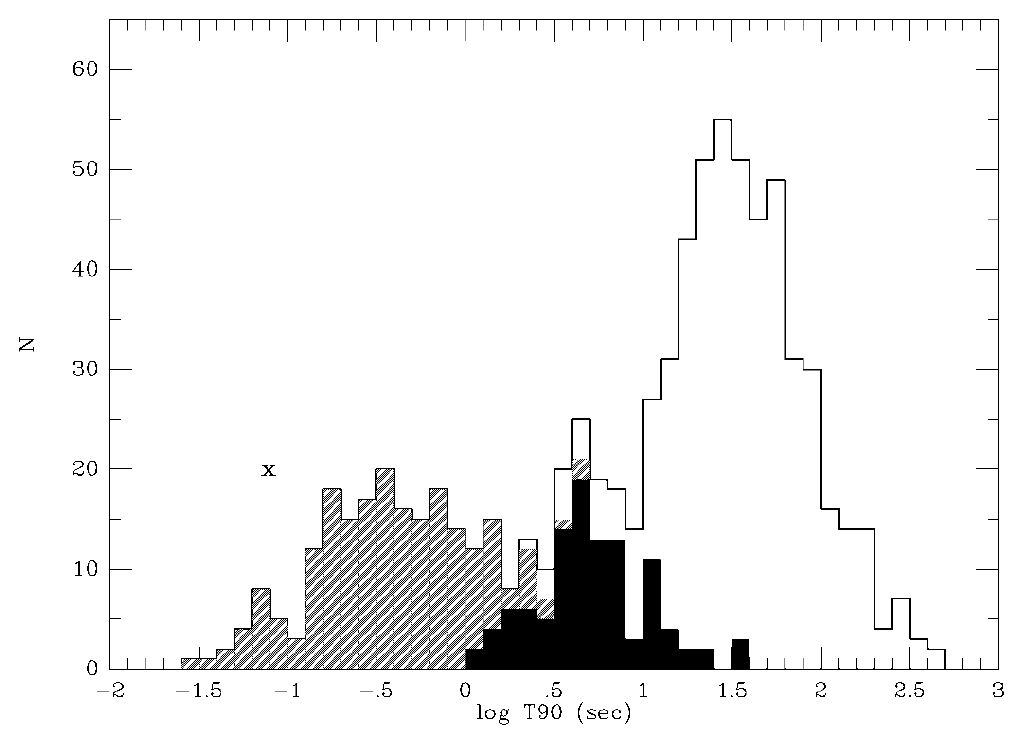
T90 means "the time during which 90 percent
of the flux arrives"
The two most obvious groups are
Over the past twenty years, many astronomers have put enormous amount of time and effort into chasing GRBs with optical and infrared telescopes. As soon as one of the gamma-ray satellites detects a burst, alerts are spread throughout the world via E-mail, and people using telescopes around the world interrupt their regular observations to snap pictures of the region around the burst location. In a few cases, this hard work has paid off.
Each of these three GRBs was one of the "long" bursts. Many astronomers now believe that some or all of the "long" bursts are caused by the core collapse at the center of a very massive star; in addition to the visible light emitted by the exploding star, some mechanism also produces a burst of gamma rays.


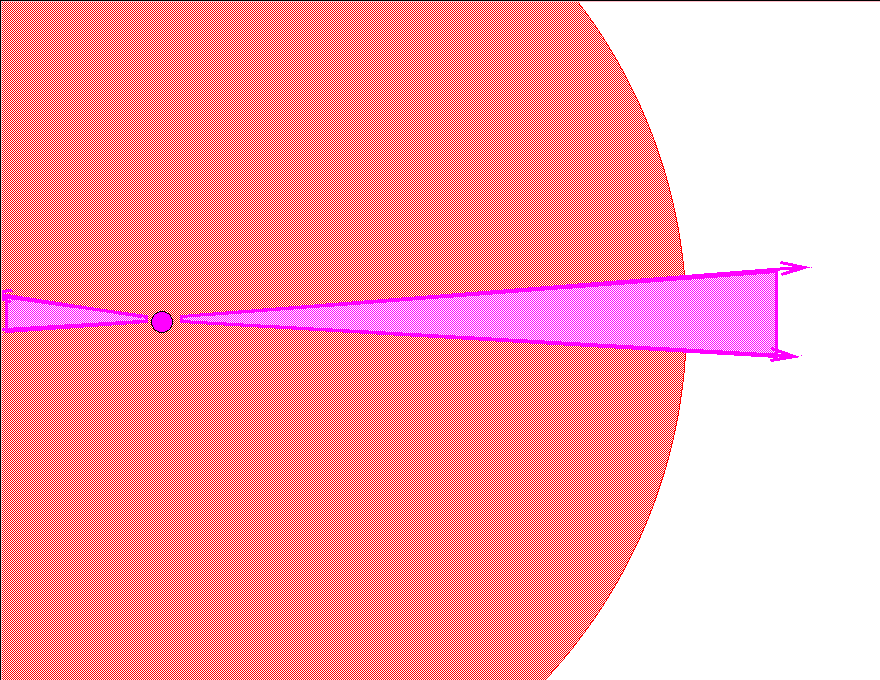
Because it takes some time -- many seconds to several minutes -- for the jet of relativistic material to fight its way through the outer layers of the star, and because the jet stirs up and heats up the surrounding material, it seems likely that a burst of energy produced by some sort of jet coming from the core SHOULD continue for several minutes. So, this all sort of makes sense to explain the "long" gamma-ray bursts.
But what about the short ones?
The SWIFT satellite, a joint effort of NASA and scientific groups in the UK and Italy, was lauched on November 20, 2004.

SWIFT was designed, not only to detect gamma-ray bursts, but also to pin down their locations very accurately. The satellite contains several instruments:
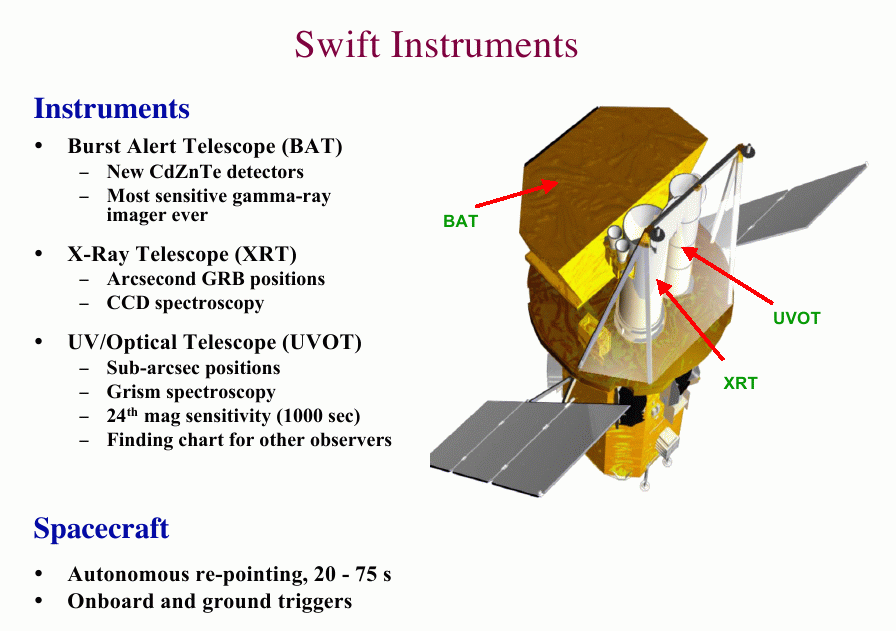
Note the very short time delay between the detection of a burst by BAT, and the subsequent measurements by the other telescopes: only about one minute. In order to move so quickly, the spacecraft has to have enough brains of its own to take action autonomously: it is not controlled remotely from the ground in a direct way after it detects a burst.
When SWIFT detects a burst of gamma rays from some direction, it turns itself so that its other telescopes can look at the same region of the sky. It uses the different telescopes to zoom in gradually on the source:
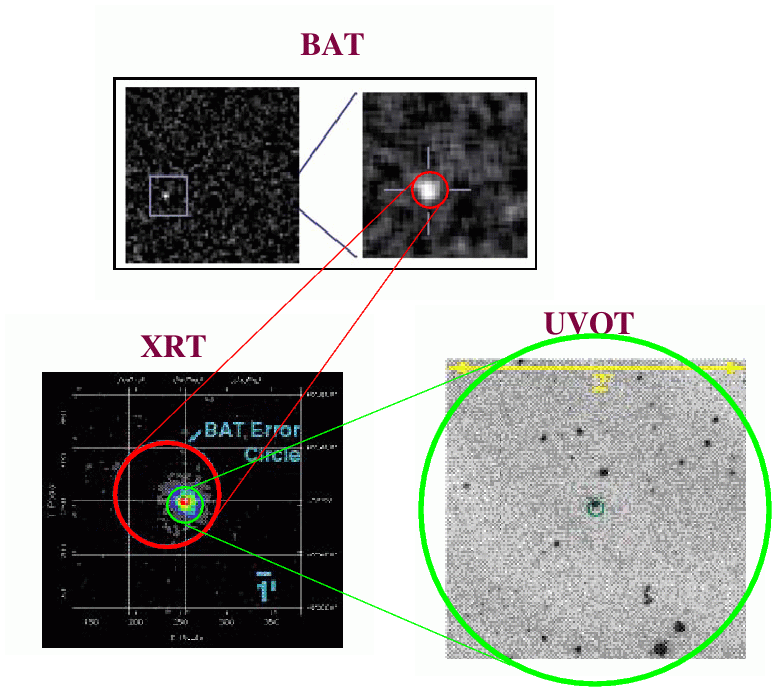
TITLE: GCN GRB OBSERVATION REPORT NUMBER: 3381 SUBJECT: Swift Detection of GRB050509b: A short duration burst DATE: 05/05/09 05:03:23 GMT FROM: Louis M Barbier at NASA/GSFC/Swift C. Hurkett, E. Rol, (U Leicester), L. Barbier (GSFC), S. Barthelmy (GSFC), A. Blustin (MSSL), D. Burrows (PSU), J. Cummings (GSFC/NRC), N. Gehrels (GSFC), J. Kennea (PSU), C. Markwardt (GSFC/UMD), S. Holland (GSFC/USRA) on behalf of the Swift Team; At 04:00:19.23 UT, the Swift Burst Alert Telescope (BAT) triggered and located on-board GRB050509b (trigger #118749). The BAT on-board calculated location is RA, dec 189.056, +29.000 (12h 36m 13s, +29d 00' 01'') (J2000) with an uncertainty of 4 arcmin (radius, 3-sigma, including estimated systematic uncertainty). The BAT light curve showed a single short spike with a duration of less than 128 milliseconds. The peak count rate measured by BAT was about 2100 counts/sec in the 15 - 350 keV band. The Swift spacecraft slewed promptly onto the BAT position. The XRT imaged the field at 04:01:12 (53.0 s after the burst), but did not find any bright source in the field. An XRT position will be determined by analysis of the full data following the next ground station pass. The Swift Ultra Violet/Optical Telescope (UVOT) observations began at 04:01:09.8 UT, 50 seconds after the BAT trigger. The first data taken after the spacecraft settled was a 100 sec exposure using the V filter with the midpoint of the observation at 100 sec after the BAT trigger. Based on a preliminary comparison with the DSS, there is a possible low significance source at RA=12:36:18, DEC=29:01:24 which is not present in the DSS. It has a V-band magnitude of 18.8.
Aha! A short burst with a relatively precise position! And there might even be an optical counterpart!
(Actually, a later message from the SWIFT team based on a refined analysis of the BAT signal states: "The 1-s maskweighted lightcurve shows two distinct peaks. T90 (15-350 keV) is (11.6 +- 1.0) seconds (estimated error including systematics)." So the burst isn't as short as originally thought ....)
It was the hint of an optical counterpart detected by SWIFT's UVOT instrument, and the precise position that this detection promised, that led to all the fuss in the press.
As soon as they received this notice, astronomers around the world turned their telescopes to the position indicated by SWIFT's XRT instrument. The RAPTOR group, for example, reported:
SUBJECT: GRB 050509b: RAPTOR deep, early limits. DATE: 05/05/11 22:18:35 GMT FROM: Przemyslaw R. Wozniak at LANL P. Wozniak, W. T. Vestrand, J. Wren, S. Evans, and R. White, on behalf the RAPTOR team at Los Alamos National Laboratory The RAPTOR-S telescope at Los Alamos National Laboratory responded to Swift trigger 118749 (Hurkett et al. GCN 3381) and collected a series of 113 unfiltered images starting at 26.57 s and continuing for the first 90 minutes after the trigger. The exposure durations are 10 s for the first 10 images, 30 s for the next 10 images and 60 s for the remaining 93 images. Using difference imaging techniques, comparing individual images as well as stacks of images, we have placed limits on early time variability at the locations of sources S1-S4 (Cenko et al. GCN 3401) within the XRT error circle (Rol et al. GCN 3395). We find no evidence for transient emission at the four candidate locations with the following 5 sigma limits
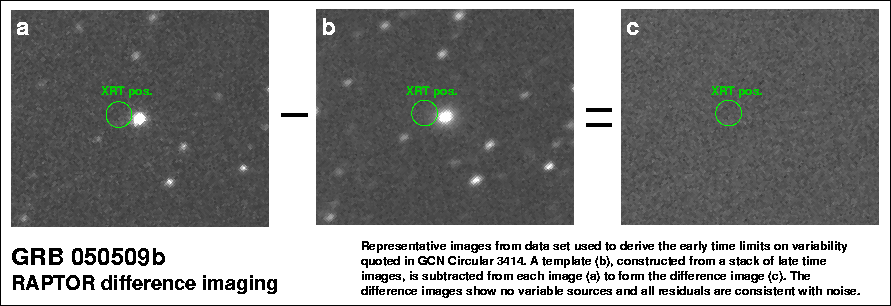
Hmmm. So this small telescope found NO optical counterpart, eh? But it could only go do as faint as magnitude 18 or so. Maybe larger telescopes might see something....
Old images of this region of the sky taken by the Sloan Digital Sky Survey show the burst occurred in the same direction as a cluster of galaxies -- the brightest blob in the RAPTOR image is actually a big, but distant, elliptical galaxy. The green circle in the picture below shows the position indicated by the XRT.
Astronomers in the Canary Islands used the 1.2-meter Mercator telescope to take images of the field reaching much deeper than the RAPTOR pictures. They declared that there was no optical counterpart down to magnitude 21.
Astronomers at Kitt Peak also noted that they could see no new optical source that was not present in earlier images, but they did suggest that the proximity of the GRB to the elliptical galaxy might mean that the GRB was associated with an object in the galaxy. Spectroscopy of the galaxy indicated that it was moving away from us very fast: an absorption line of calcium which normally appears at 396.8 nm was found at 484.1 nm.
Q: What is the velocity of this galaxy
away from the Sun?
Estimate the distance to this galaxy.
A closeup taken with the Keck 10-m telescope in the optical showed several very faint sources within the error circle.
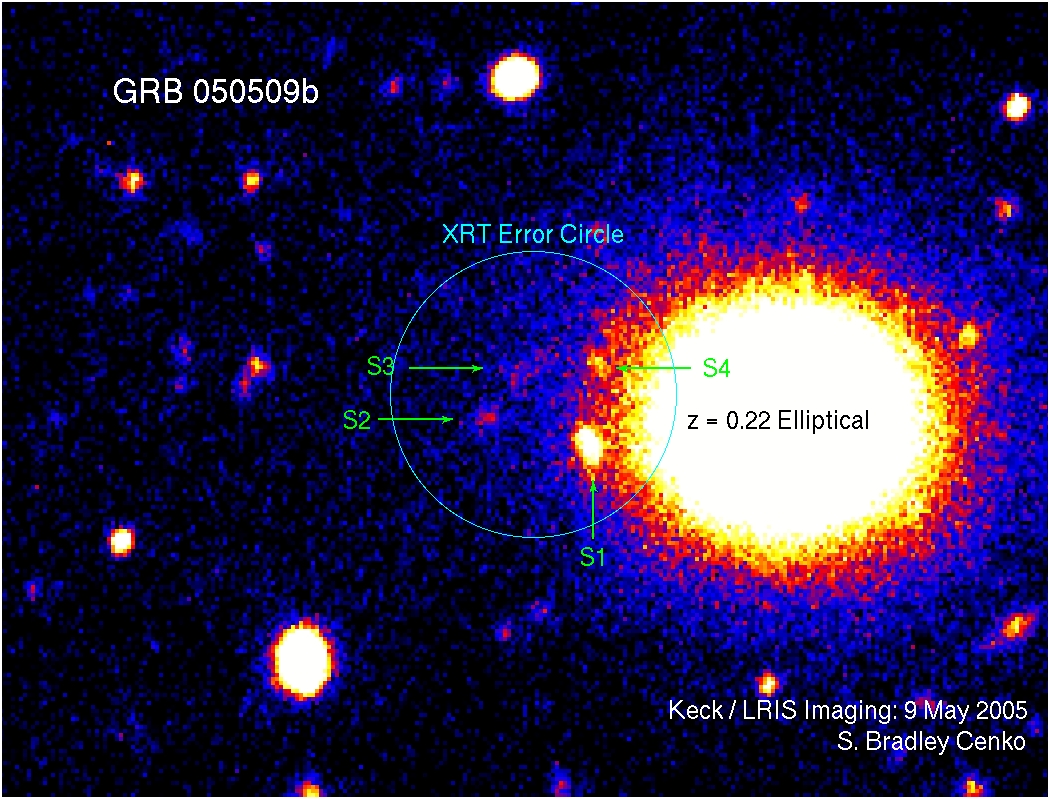
The Chandra telescope got into the act, too: astronomers quickly interrupted its normal schedule for a 50,000 second exposure! They found several faint sources within the error circle -- none of which matched up exactly with any of the optical sources.
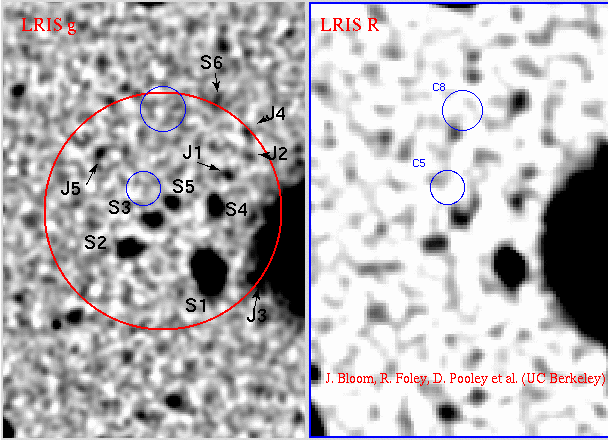
Now, which of these faint sources, optical or X-ray, corresponds to the GRB? It's hard to say: the only images we have of the field before the burst are not deep enough to compare with the images taken after the burst; we can't tell which optical source (if any) wasn't there before the burst.
So, what astronomers do is to take picture after picture, night after night, and measure the brightness of each object carefully. The optical counterpart to a GRB ought to change in brightness over the course of several hours or days. Do any of the faint sources detected by astronomers near the location of GRB 050509B actually vary?
At first, it seemed that perhaps one did: the brightest of the optical sources within the XRT error circle (S1 in the charts above) appeared to vary slightly from one image to another taken about 90 minutes later. Could this be the optical counterpart to the GRB? Only further study would tell....
Several days after the event, astronomers HAVE made more measurements. Here's a recent announcement:
SUBJECT: GRB 050509b: No Optical Variability in XRT Error Circle DATE: 05/05/11 06:45:45 GMT FROM: S. Bradley Cenko at Caltech S. Bradley Cenko, B. T. Soifer, Chao Bian, Vandana Desai, S. R. Kulkarni (Caltech), Brian P. Schmidt (ANU), Arjun Dey, and Buell T. Jannuzi (NOAO) report on behalf of the Caltech-NRAO-Carnegie GRB collaboration: We have continued to image the field of GRB 050509b with the Low Resolution Imaging Spectrometer mounted on the 10-m Keck I telescope. Our latest observations consisted of 3 x 300 s images simultaneously in the g' and R filters. The mean epoch of these observations was approximately 5:56 UT 10 May (25.8, 25.9, and 26.0 hours after the burst, respectively). We stacked all the R-band images obtained on 9 May (GCN 3391, GCN 3401) and differenced this from the stack obtained on 10 May. Adopting the value of R = 18.5 for the USNO-A2 star located at RA 12:36:19.970, DEC +29:00:36.31 (J2000.0), we find no variation within the revised XRT error circle (GCN 3395) to a limiting magnitude of R = 25.6. Specifically for the extended source in the XRT error circle (S1 in GCN 3401), we find this object has not varied by more than +/- 0.18 magnitudes from 9 May to 10 May. It is therefore unlikely that any of the 4 sources identified in GCN 3401 is the optical afterglow of GRB 050509b.
Sigh. It may turn out that, after all the fuss and bother and efforts by astronomers around the world, we can't identify a counterpart to this gamma-ray burst at other wavelengths. That means that we may not be able to study the event in any more detail ... which may mean that the nature of the "short bursts" will remain a mystery, for now, at least.
 Copyright © Michael Richmond.
This work is licensed under a Creative Commons License.
Copyright © Michael Richmond.
This work is licensed under a Creative Commons License.